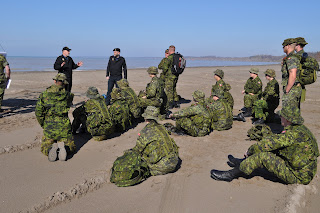Ground Level Interoperability
By SLt David Lewis, PAO, HMCS PREVOST due to the uprising in
the city of Port Shara in Obinia, the Canadian government had directed that all
Canadian citizens be evacuated from that country. 31 Combat Engineer Regiment
(31 CER) “The Elgins” were tasked with providing the assault boats and
engineers to assist in the evacuation. HMCS PREVOST would provide blue water
escort from HMCS Fredericton to the beaches.
This was the frag order being read on the beach of Port
Stanley, Ontario. It was early Saturday morning in the small seaside community on
the north shore of Lake Erie. Families strolled along the sand, people were
flying kites, and the scent of french-fries began to waft through the air. It
was a typical warm spring day, other than the 30 cadpatted Elgins, the 4
assault boats on the shore, and the naval personnel patrolling in the rigid
hulled inflatable boat (RHIB).
In this budget-conscious era it is impressive to see the
innovative training conceived and conducted at the local unit level. Army reservists
from 31 CER in Waterloo and St. Thomas, Ontario, and Naval Reservists from HMCS
PREVOST in London participated in this combined exercise. The training was planned
and directed to provide maximum benefit to those involved. The Army has great success
in river crossings but limited experience in large open water crossings. This
exercise provided a unique opportunity to expand their blue water capability.
Sailors also benefited through the experience of presenting briefings on open
water safety, small boat handling, and navigation. The HMCS PREVOST RHIB also participated
by escorting 31 CER on their assault on the beach.
The exercise provided a scenario for all involved to gain
new knowledge and experience. The Canadian Forces doctrine of interoperability
was tested, practiced and achieved. These two units have found a way to work
together to maximize the training potential for all involved.

No comments:
Post a Comment